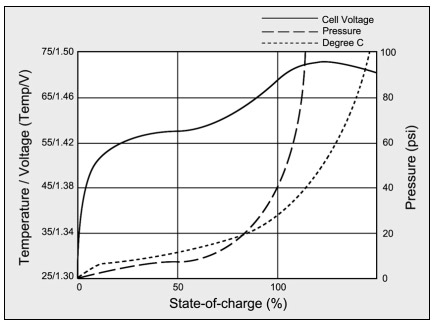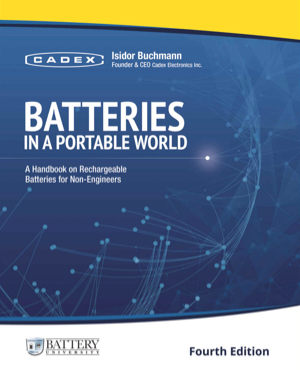Again Again Cc 8 Battery Charger
Nickel-based batteries are more than circuitous to charge than Li-ion and pb acid. Lithium- and lead-based systems are charged with a regulated current to bring the voltage to a set limit later which the battery saturates until fully charged. This method is chosen abiding current abiding voltage (CCCV). Nickel-based batteries too charge with constant current but the voltage is allowed to rise freely. Full charge detection occurs by observing a slight voltage driblet after a steady rise. This may be connected with plateau timing and temperature rise over time (more below).
Bombardment manufacturers recommend that new batteries exist slow-charged for 16–24 hours before use. A slow charge brings all cells in a battery pack to an equal charge level. This is important because each cell within the nickel-cadmium battery may take self-discharged at its own rate. Furthermore, during long storage the electrolyte tends to gravitate to the bottom of the cell and the initial slow charge helps in the redistribution to eliminate dry spots on the separator. (Meet also BU-803a: Loss of Electrolyte)
Battery manufacturers do not fully format nickel- and atomic number 82-based batteries earlier shipment. The cells reach optimal performance after priming that involves several charge/discharge cycles. This is role of normal apply; it can also be washed with a battery analyzer. Quality cells are known to perform to full specifications after simply v–7 cycles; others may take fifty–100 cycles. Elevation capacity occurs between 100–300 cycles, after which the operation starts to drop gradually.
Most rechargeable cells include a safety vent that releases backlog pressure if incorrectly charged. The vent on a NiCd cell opens at one,000–1,400kPa (150–200psi). Pressure released through a re-sealable vent causes no harm; however, with each venting consequence some electrolyte escapes and the seal may begin to leak. The germination of a white powder at the vent opening makes this visible. Multiple venting eventually results in a dry-out condition. A battery should never be stressed to the point of venting.
Full-charge Detection by Temperature
Full-charge detection of sealed nickel-based batteries is more complex than that of pb acid and lithium-ion. Low-price chargers ofttimes apply temperature sensing to cease the fast charge, but this can exist inaccurate. The core of a cell is several degrees warmer than the pare where the temperature is measured, and the delay that occurs causes over-charge. Charger manufacturers employ 50°C (122°F) equally temperature cut-off. Although any prolonged temperature above 45°C (113°F) is harmful to the battery, a brief overshoot is acceptable as long equally the battery temperature drops chop-chop when the "prepare" light appears.
Avant-garde chargers no longer rely on a stock-still temperature threshold but sense the charge per unit of temperature increase over time, likewise known as delta temperature over delta time, or dT/dt. Rather than waiting for an absolute temperature to occur, dT/dt uses the rapid temperature increment towards the end of charge to trigger the "ready" light. The delta temperature method keeps the battery cooler than a fixed temperature cutting-off, just the cells need to charge reasonably fast to trigger the temperature ascension. Accuse termination occurs when the temperature rises i°C (i.eight°F) per infinitesimal. If the battery cannot achieve the needed temperature ascension, an absolute temperature cut-off set to threescore°C (140°F) terminates the charge.
Chargers relying on temperature inflict harmful overcharges when a fully charged battery is repeatedly removed and reinserted. This is the example with chargers in vehicles and desktop stations where a two-mode radio is being discrete with each utilize. Reconnection initiates a new charge cycle that requires reheating of the bombardment.
Li ion systems accept an advantage in that voltage governs country-of-charge. Reinserting a fully charged Li-ion bombardment immediately pushes the voltage to the total-charge threshold, the current drops and the charger turns off soon without needing to create a temperature signature.
Total-charge Detection by Voltage Signature
Advanced chargers terminate accuse when a defined voltage signature occurs. This provides a more precise full-accuse detection of nickel-based batteries than temperature-based methods. The charger looks for a voltage drib that occurs when the battery has reached full charge. This method is chosen negative delta V (NDV).
NDV is the recommended total-charge detection method for chargers applying a charge charge per unit of 0.3C and higher. It offers a quick response fourth dimension and works well with a partially or fully charged bombardment. When inserting a fully charged bombardment, the terminal voltage rises rapidly and then drops sharply to trigger the set up state. The charge lasts but a few minutes and the cells remain cool. NiCd chargers with NDV detection typically respond to a voltage drop of 5mV per cell.
To achieve a reliable voltage signature, the accuse rate must be 0.5C and higher. Slower charging produces a less divers voltage drop, especially if the cells are mismatched in which example each cell reaches full charge at a different time point. To assure reliable total-charge detection, virtually NDV chargers also use a voltage plateau detector that terminates the charge when the voltage remains in a steady state for a given time. These chargers also include delta temperature, accented temperature and a time-out timer.
Fast charging improves the charge efficiency. At 1C charge rate, the efficiency of a standard NiCd is 91 percent and the charge time is most an hour (66 minutes at 91 percent). On a dull charger, the efficiency drops to 71 per centum, prolonging the accuse time to about 14 hours at 0.1C.
During the first 70 percent of charge, the efficiency of a NiCd is close to 100 percent. The battery absorbs almost all free energy and the pack remains cool. NiCd batteries designed for fast charging can exist charged with currents that are several times the C-rating without extensive oestrus buildup. In fact, NiCd is the only battery that can be ultra-fast charged with minimal stress. Cells made for ultra-fast charging can exist charged to 70 per centum in minutes.
Figure 1 shows the human relationship of prison cell voltage, pressure and temperature of a charging NiCd. Everything goes well up to about 70 percent charge, when charge efficiency drops. The cells begin to generate gases, the pressure rises and the temperature increases rapidly. To reduce battery stress, some chargers lower the accuse rate past the 70 percent mark.

Accuse efficiency is high up to lxx% SoC* and then accuse acceptances drops. NiMH is similar to NiCd. Charge efficiency measures the battery's ability to accept charge and has similarities with coulombic efficiency.
* SoC refers to relative land-of-accuse (RSoC) reflecting the actual free energy a bombardment tin can store. Full charge volition show 100% even if the capacity has faded. (Run into BU-105: Battery Definition and what they mean)
Ultra-loftier-chapters NiCd batteries tend to heat up more than standard NiCds when charging at 1C and college and this is partly due to increased internal resistance. Applying a high current at the initial charge and so tapering off to a lower rate as the accuse credence decreases is a recommended fast accuse method for these more fragile batteries. (See BU-208: Cycle Performance)
Interspersing discharge pulses betwixt accuse pulses is known to improve accuse acceptance of nickel-based batteries. Commonly referred to every bit a "burp" or "reverse load" accuse, this method assists in the recombination of gases generated during charge. The result is a libation and more effective charge than with conventional DC chargers. The method is as well said to reduce the "memory" effect equally the battery is beingness exercised with pulses. (See BU-807: How to Restore Nickel-based Batteries) While pulse charging may be valuable for NiCd and NiMH batteries, this method does not use to lead- and lithium-based systems. These batteries piece of work best with a pure DC voltage.
After full charge, the NiCd battery receives a trickle charge of 0.05–0.1C to compensate for self-discharge. To reduce possible overcharge, charger designers aim for the lowest possible trickle charge current. In spite of this, it is best not to leave nickel-based batteries in a charger for more a few days. Remove them and recharge earlier use.
Charging Flooded Nickel-cadmium Batteries
Flooded NiCd is charged with a constant current to virtually i.55V/prison cell. The current is and then reduced to 0.1C and the charge continues until 1.55V/prison cell is reached again. At this bespeak, a trickle charge is applied and the voltage is allowed to bladder freely. Higher charge voltages are possible but this generates backlog gas and causes rapid water depletion. NDV is not applicable equally the flooded NiCd does non blot gases because it is non under pressure.
References
[1] Source: Cadex

Batteries In A Portable Globe
Source: https://batteryuniversity.com/article/bu-407-charging-nickel-cadmium
0 Response to "Again Again Cc 8 Battery Charger"
Post a Comment